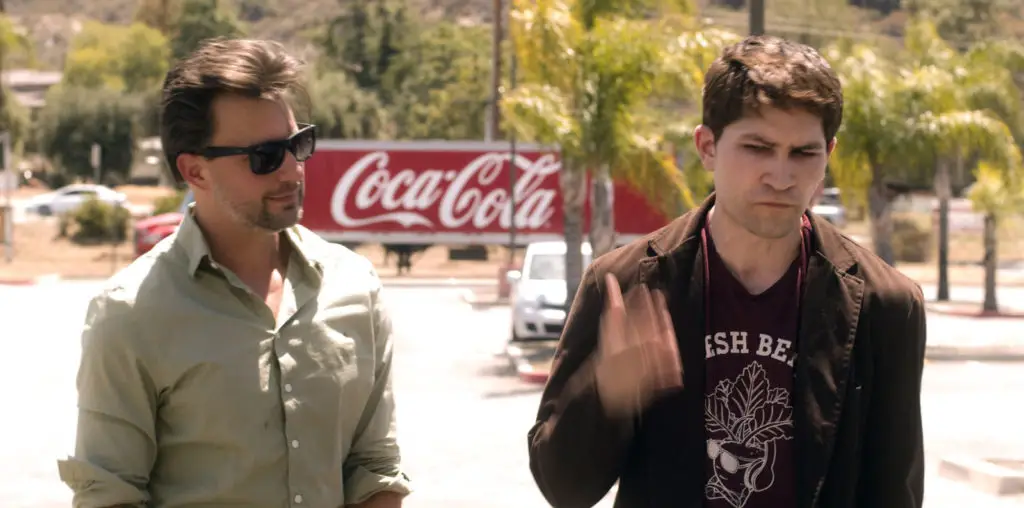
DVD label Lowave teams with Label Ombres to present this uneven collection of shorts created by a loosely associated group of young artists, most of which were originally intended as unique events, live performances employing extended cinema techniques. The enclosed booklet shares an unfortunate tendency I’ve noticed in program notes for experimental film: providing notes which consist of badly written, incomprehensible prose poems, which do not help to illuminate the films, and provide little pleasure on their own. The filmmakers included in this collection, incidentally, share another unfortunate tendency with other experimental film artists: a propensity for making closing credits for their films which are artfully distorted so that they are impossible to read, as if to prove that they would never stoop so low as to actually wish to communicate something to an audience.
“The Body of Winds” presents a collectively created soundtrack, credited to FredŽric D. Oberland, of ostinatos, noises, and obstinately inept drumming. The extremely restrained, minimalist visuals include very occasional wispy flashes of light on a black screen. (The screen is totally black for the first four minutes.) Occasional subtitles show an opaque, poetic text by director Mika‘l Rabetrano, apparently having to do with love. The accompanying “making of…” documentary, in the form of a double screen projection, makes clear what is going wrong here. In the doc, as we watch this group of young artists feverishly banging on pots and exposing film, we see all of the passion and energy which is completely missing from the final product. They have not learned the trick of transferring the excitement of an improvisation into the work, so that it becomes visible and audible for the audience.
Another Rabetrano/Oberland collaboration, the 2 minute “Elez,” combines black and white stripes, dancing schmutz, and screeching noises. It has no particularly expressive or original qualities.
Director Carole Arcega’s artistic skill and clear personal vision make her a stand-out in this group. She is obsessed with exploring a tactile, highly physical identification between herself and the filmstrip. Her 7 minute short “Le Cristallin” appears to be made from shots of melting celluloid, interspersed with flashes of light and black frames, but it could just as well be layers of melting ice or the nerve tissue inside a brain. The textures in the film are so palpable one really does feel as if one is entering the filmstrip. Franck Rochard’s score of looped noise does not contribute appreciably to the experience.
In Arcega’s second film on the DVD, the 16 minute “Macula,” a naked body is seen first immersed in water, and later sheathed in rubber. Layered with bubbly, plastic textures, the imagery has a distinctly fetal look. Once again, Arcega has created a highly effective sense of the body merging with materials that seem foreign to it. Sebastian Cros’ score of breathing sounds and electronic noises heighten the tactile strangeness of the film. The final sequence, in which both the music and the white and black negative images reach a violent intensity, creates a kind of nightmare vision, in which the body seems to be on fire. (The enclosed booklet promised some stills from this film as well, but I couldn’t locate them on the DVD.)
Cros’ performance/film “Tabula Rasa” is a double screen projection, containing random images of spiders, windows, scaffolding, etc. The two screens are overlaid by patterns of crackly black and white patterns. The sound score is a collage of ambient noise. The film’s title and style firmly link it to the “random collection of interesting things to look at and listen to” school of art, pioneered 60 years ago by John Cage. When Cage first started making such pieces in the 1940s, they served a very important function: they taught us that some of the most interesting combinations of images and sounds are achieved when the artwork is liberated from the conscious intention of the artist to “express himself.” They likewise taught us that everything in the world can be seen as having the same beauty as an artwork, and that if we listened and looked at our everyday world with the same intensity we usually reserve for art, we could fill our lives with aesthetic pleasure.
60 years later, these ideas are extremely familiar to us, and they no longer have the power of liberating our imaginations that they once did. Cage’s piano piece “4 minutes 33 seconds,” in which the pianist sits at the piano without playing anything for the specified duration, has long since taught me that the ambient sound in any space can be as beautiful as any music. Now, when I am in the mood to seek aesthetic pleasure from random input, I greatly prefer to go outside and take a walk, where the random sensations will not only be interesting, they will tell me something about the larger world, and I will furthermore be able to direct my own attention wherever I choose. I no longer particularly have a need to ask artists to assemble these random impressions on my behalf. Like many people under 60, I’ve been seeing this kind of work for my entire life, and I wonder if I’m the only one who no longer feels the need for it.
